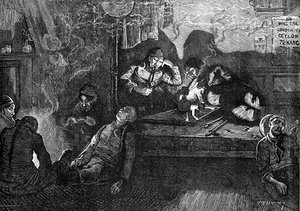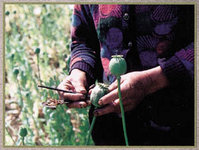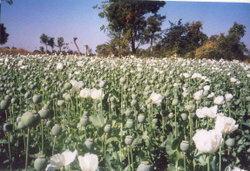ZEVA'S eyes filled with tears as the 10-year-old's father took her by the arm and handed her to the moneylender. 'I cannot pay you in any other way. Take my daughter,' said Gul Miran, a farmer in Nangarhar province. Like many other farmers in Afghanistan, Gul Miran had planned to pay back his loan of 50,000 Afghanis (around $1,000) with the proceeds from his crop of opium poppies, which would eventually be turned into heroin. But as part of its stepped-up effort to combat the drug trade in the country, the Government has ploughed under his fields, leaving Gul Miran with nothing.
The moneylender, Haji Naqibullah, accepted the offer, 'We had an agreement. He would [pay me back] regardless of whether his crops were wiped out by the weather or by the Government. In a year or 18 months I will marry [the girl] off to my youngest son. He is 19 years old and has been married to his first wife for two years but has not had a child yet.'
Despite the enormous amount of international aid being pumped into Afghanistan--an estimated $14 billion over the last three years--the money is not reaching many who need it. As a consequence, the people are turning back to the cultivation of opium poppies. A recent UN Office on Drugs and Crime report estimates that 356,000 Afghan families were involved in opium poppy cultivation in 2004: a 35 per cent increase on the previous year. Their poppy fields produced a staggering 87 per cent of the world's opium last year.
[ILLUSTRATION OMITTED]
Last December, two days after being sworn in as Afghanistan's first popularly elected president, Hamid Karzai called on his country to wage holy war against the opium trade. But poppy grower Payenda Gul, who gave his 17-year-old daughter to a 38-year-old divorced man in order to pay off his debt, sets out the conundrum facing the Government: 'They cannot do anything about the big drug dealers [so] they come and plough up the small farmers' poppies.'
An official with the International Committee on Human Rights says: 'Unfortunately many of these women who are used as payment for opium debts either end up addicted to the drug or commit suicide. It's a very sad situation. However, there is little that the organization can do unless official complaints are lodged.'
And that is unlikely. As Syed Jafer Muram, deputy director of the Nangarhar narcotics-control section, explains: 'Cases like this don't come to the notice of officials. If a father tried to get help for his daughter he would be arrested for opium trading.'
Haytullah Gaheez in Jalalabad for the Institute for War & Peace Reporting (www.iwpr.net)
COPYRIGHT 2005 New Internationalist Magazine
COPYRIGHT 2005 Gale Group




